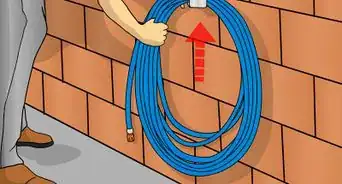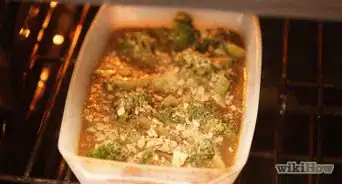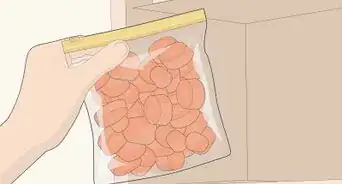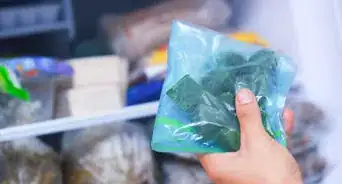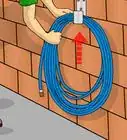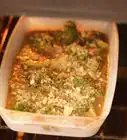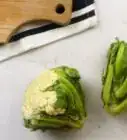wikiHow is a “wiki,” similar to Wikipedia, which means that many of our articles are co-written by multiple authors. To create this article, 26 people, some anonymous, worked to edit and improve it over time.
The wikiHow Culinary Team also followed the article's instructions and verified that they work.
This article has been viewed 498,091 times.
Learn more...
Don't you love the taste of fresh, sweet corn? Though it's only available a few weeks out of the year, you can buy it in bulk and enjoy that fresh taste all year long. What follows is a complete guide to choosing, preparing and freezing large batches of corn.
Steps
Prepping the Corn
-
1Find the ears that are just right. Everybody's got their own definition of what's too big and too small to be tasty, but a good rule of thumb is to shake hands with the corn. If the cob fills your hand nicely and the silk on the top is brown, it's ready to pick. If it feels too scrawny, look for larger cobs to freeze.
-
2Husk the corn. Have a seat and take all the husks off the corn once you've picked enough corn for your purposes. Collect the corn in a bowl and dispose of the husks.
- For a classic country husking, sit outside in the afternoon sun and husk your corn.
Advertisement -
3Clean the corn. Rub the silky fibers off the cleaned cobs with your hands.[1] It helps to keep a bowl of water on the table while working to dip your hands into, otherwise you end up feeling like Spiderman with everything you touch sticking to your hands.
Blanching the Corn
-
1Boil a pot of water large enough to fit your cobs. There are other methods of preparing and cooking the corn, but many believe this method gives the best taste. Put the corn in the water, put the lid on, and bring the water back to a rolling boil.
-
2Remove the corn from the water. You need to do this as quickly as possible to maintain the right texture of the corn. Take the corn out when the water's boiling and cool it down by submerging the corn in ice water.
- If you have lots of corn to freeze, use one side of the sink to cool the hot ears just off the stove, then move the lukewarm ears to the left side of the sink to finish up the cooling. Cold water trickles in from the faucet into the left hand side of the sink.
-
3Cut the corn off the cob. Once the corn has been blanched and cooled so that the ears are cool to the touch, use a sharp knife and run it down the cob vertically. Go slowly, and try to get enough corn without getting too much of the cob.
- You can also freeze corn still on the cob if you would prefer that option, but if you plan to eventually cut the corn off the cob, it's easiest to do so before freezing rather than doing so after thawing.
Freezing the Corn
-
1Chill the corn. Once the corn is off the cob, put it into cake pans or baking sheets for a good initial freezing. Cake pans work well because they spread out the corn and transfer the heat nicely. Freezing the corn on a flat surface is a good idea to freeze each kernel individually and ensure that you don't have a big, difficult to manage, block of starchy corn when you defrost it.
- If you're freezing lots of corn, cycle the warmest batches from the cooler to the freezer to keep the temp of the freezer high. Don't put extremely hot corn straight into the freezer, or you'll lower the temperature and slow down the process considerably.
- You don't have to freeze them initially before bagging them, but it is a good idea to cool them down by doing this process at least for a little while.
-
2Bag the corn. Once the pans of corn are completely cooled, all that's left is to package the corn up for final freezing. Use quart and pint Ziploc baggies and portion the corn into meal-sized amounts. Squeeze as much air as you can out of the bags before zipping them up.
- Don't overfill the bags. You don't want them totally full, just enough so you can close them easily and then flatten them out so they store easily. A quart baggie is about enough for one meal for 4-5 people, and a pint baggie works well for 2 people.
-
3Freeze the bags. Stack them as flat as possible in your freezer. It's a good idea to date them and label the bags before putting them into the freezer for later. Frozen, sweet corn should be good for several months up to the next year.
Community Q&A
-
QuestionCan I freeze raw corn off the cob?
 Community AnswerRaw veggies carry bacteria. Blanching kills off the bad bacteria, then it is suitable for freezing. Blanching only takes a moment., and it doesn't cook the corn through.
Community AnswerRaw veggies carry bacteria. Blanching kills off the bad bacteria, then it is suitable for freezing. Blanching only takes a moment., and it doesn't cook the corn through. -
QuestionHow do I freeze whole cobs of corn?
 KateKatey GirlCommunity AnswerI've always just rinsed the cobs a bit and let them sit to dry for a while, then thrown them into Ziploc bags, getting as much air out as possible before putting them in the freezer.
KateKatey GirlCommunity AnswerI've always just rinsed the cobs a bit and let them sit to dry for a while, then thrown them into Ziploc bags, getting as much air out as possible before putting them in the freezer. -
QuestionCan I put up fresh squash in the freezer for frying later?
 KateKatey GirlCommunity AnswerFreezing most all squashes cause it to be pretty mushy when it thaws. It is good for soups or casseroles, but once frozen, it won't hold up to frying.
KateKatey GirlCommunity AnswerFreezing most all squashes cause it to be pretty mushy when it thaws. It is good for soups or casseroles, but once frozen, it won't hold up to frying.
Warnings
- Keep things clean so that you don't end up with contaminated food.⧼thumbs_response⧽
Things You'll Need
- Lots of corn
- Big pan for boiling the corn
- Some sharp knives
- 6-8 empty cake pans
- A mostly empty refrigerator and freezer
- Ziploc baggies
References
About This Article
To freeze fresh corn, start by taking the husks off the cobs and removing the silky fibers. Next, boil water in a large pot and submerge all your cobs, or as many as possible. When the water comes back to a rolling boil, remove the corn and immediately submerge them in ice water. Then, cut the corn off the cobs with a sharp knife, place the kernels on a baking sheet and put them in the freezer. Once the kernels are completely cooled, transfer them to Ziploc baggies and keep them in the freezer for up to 1 year. For helpful tips, like bagging your corn in meal-sized amounts before putting them in the freezer, read on.

